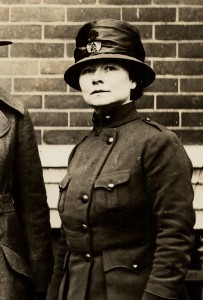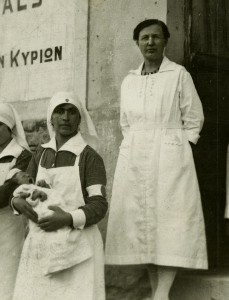Working with the Sources: The American Women’s Hospitals in the Near East
The American Women’s Hospitals (AWH) was started in 1917 to provide, register and finance American women physicians for war work; to offer medical and emergency relief to refugees; and, later, to provide international public health service. The following is an excerpt from Virginia Metaxas's article on the AWH use of field information to publicize and raise funds for their ongoing work. The full article can be found here.
by Virginia Metaxas, Ph.D., Professor of History and Women’s Studies, Southern Connecticut State University Legacy Center 2010 M. Louise Carpenter Gloeckner Fellow

Refugee camp on the island of Macronissi, circa 1922.
The largest American Women’s Hospitals projects in the 1920s and 1930s were in Greece, where long term medical aid was desperately needed, due to the devastation left by the First World, Balkan, and Greco-Turkish Wars. To meet the vast needs for medical relief, President Esther Pohl Lovejoy found that she had to spend much of her time fundraising. As early as 1919, she realized that she needed to capitalize on human interest stories as well as factual material in order to procure private and public support of the AWH projects. In a letter written to Dr. Ruth A. Parmelee, a physician and medical missionary working in Harpoot [now Harput] Turkey, Dr. Lovejoy succinctly said:
We are very much interested in the work you are doing and we should greatly appreciate a more complete description of the cases you are meeting. I observe that your total number of treatments for the month of August was something over three thousand. It is very helpful in this office to have letters descriptive of conditions that are of human interest. In other words, stories of suffering and heroism such as will help us in our effort to secure funds to continue this work.1
Dr. Parmelee, who served in Greece for three decades in various capacities under the auspices of the AWH, took Dr. Lovejoy’s advice to heart. She became, in a very real way, an impassioned advocate for the continued support of the Christian Greeks and Armenians she worked among both in Turkey and in Greece. Without exaggeration, Parmelee was one of the most articulate reporters of conditions witnessed by AWH staff abroad. Having grown up in Turkey, the daughter of missionary parents, and a fluent speaker of many of the Near Eastern languages (Armenian, Greek, Turkish), she may have had a particularly empathetic feeling for the people with whom she worked. Through her four decades of work in Turkey and Greece, she sent a constant stream of information from the field to the AWH office in New York, the American Board of Commissioners for Foreign Missions in Boston, other professional medical women’s organizations, and to the general public in the form of medical reports, professional and newspaper articles, books, private and public letters, speeches, lectures, and more. Dr. Lovejoy was supreme at this sort of activity, publishing three major books and hundreds of professional and lay articles, giving speeches and lectures, and participating in other promotional activities too numerous to count. She required all of the AWH physicians working in the field to send statistical data as well as ‘stories’ for use in publicity materials used for fundraising. These abundant and varied materials, many of which are located in the Records of the American Women’s Hospitals, are a windfall to historians seeking documentation of the work of the AWH. It is also the task of the historian to identify biases in sources and to situate their significance in a larger context.

Dr. Esther Pohl Lovejoy, 1918.

Dr. Ruth Parmelee and nurse. Salonica, Greece, 1922.
Lovejoy’s and Parmelee’s work in reporting what they saw and heard, and their calls for support and action, built upon a tradition set in motion earlier by secular and missionary Americans who had served in various Near Eastern locations. In the context of rising nationalisms in the region, Americans had witnessed many years of conflict between the Muslim Turks, who they often characterized as feared, despised, and uncivilized “Mohammedans,” and Greeks and Armenians, who they characterized as “Christian martyrs,” especially in the context of resistance to Ottoman rule. Indeed, late nineteenth and early twentieth century reports from American missionaries and diplomats had resulted in widespread public awareness of the plight of Armenians and Greeks in the waning final years of the Ottoman Empire. Many grassroots organizations, both religious and secular, conducted massive public fundraising campaigns so that American citizens knew of and contributed to saving the thousands of “starving Armenians” displaced by the conflict in the area.2 The Greek genocide and forced population exchange of 1922 became part of the American consciousness through the efforts of American witnesses who sought to form public attitudes and possibly achieve humanitarian intervention. These unprecedented international human rights campaigns helped shape America’s national and international identity.3 AWH fundraising efforts shrewdly adopted these familiar tropes as a means of obtaining the funds to provide medical relief. They joined the chorus of voices speaking against the growing evidence of ‘Turkification’ perpetrated by the Kemalist government, policies that resulted in the ethnic cleansing of Christian populations in the region. Read the full article.
1Italics mine. Letter to Dr. Ruth A. Parmelee from Chairman EL (Esther Pohl Lovejoy), November 26, 1919, Records of the American Women’s Hospitals, Acc. 144, Box 9, Folder 73. The Records of the American Women’s Hospitals are located at Drexel University College of Medicine, The Legacy Center Archives and Special Collections, Philadelphia, PA 19129. Thanks to the generosity of the M. Louise Carpenter Gloeckner, M.D. Summer Research Fellowship, I was able to spend several weeks at the archives during the summer of 2010. I am very grateful to have received this support and for all the wonderful help of the staff there, including Joanne Murray, Director, Margaret Graham, Digital Resources Archivist, Lisa Grimm, Assistant Archivist, (who left shortly after I arrived) and Karen Ernst, Administrative Assistant. Their expertise and welcoming ways made my stay there very productive and joyful.
2A recent treatment of the Armenian genocide and the response by the American public and government can be found in: Peter Balakian, The Burning Tigris: The Armenian Genocide and America’s Response (New York: Harper Collins, 2003).
3See Barbara Reeves-Ellington’s dissertation “That our daughters may be as corner stones: American missionaries, Bulgarian nationalists, and the politics of gender” (Graduate School of Binghamton University State University of New York, 2001) for a critical study of the role of American women missionaries in shaping U.S. ambitions for empire during the nineteenth century in the Ottoman Empire.